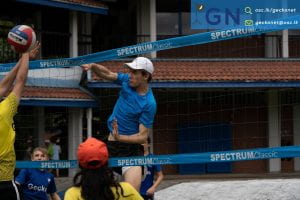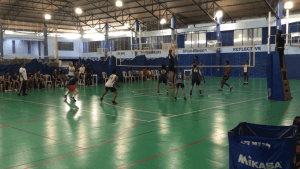I’ve been waiting for nearly a year to start playing proper volleyball again, and finally the time has come. Last year, I was captain of the volleyball team and we ended the training season with a great tournament in Kathmandu. As this is probably my last SAISA, I train as hard as I can, eager to play as well as I can in the concluding tournament, which will be hosted in Oman this year.
The first session was quite busy, with about 20 players and several who had not played volleyball before, so it was great to see many new people being motivated and passionate about this great sport. However, it also made training difficult as I could not focus on my own areas of weakness but instead made sure that the newcomers knew what to do. We had several good players, and during warm-ups I had good rallies with some of the other players, which made the training season very promising.
The sessions included passing, spiking and serving drills, often including a group of players. For myself, I focused on the accuracy of my receives, as I realized last year that if the receives are not accurate, the setter cannot make a good set. Additionally, I tried to get better spikes, first of all because I will be playing power hitter position and because my shots last year were not very good and I am eager to improve. I was still not receiving perfectly most of the time, but my spikes improved significantly since last year, which was very satisfying. All the other areas I tried to improve as well, but since I am aware that I cannot improve noticeably in all aspects, these are where I put most of my effort.

Me attempting to block a player from Dhaka last SAISA volleyball tournament. Blocking was one of the main focuses for the team during training. Photo credits: Lincoln School
Several times during the season we had games versus other schools, and this was a great opportunity to apply the skills we worked on during the training sessions. Although the games were only friendly, I did my best to improve as much as I can. In the first game we had we won two out of 5 sets, which was quite surprising considering we do not have much experience as a team. What was great to see in this game already was the excellent team spirit. This being my last SAISA, I really want to do as well as I can, which is often conflicting with schoolwork I have to do, but I always found a way to accommodate both.

Me spiking during sports day. Photo credits: GeckoNet.
A way that was good to see where my weaknesses were was looking at the videos of the games we played. They were particularly good in observing how I and the rest of the team moved around the court. I realized that we weren’t all ready all the time, which can be seen in a photo below where some players just stand on the court without seeming ready to receive or recover the ball. Although positioning and being ready are two major components of playing volleyball well, these are also very difficult. This is because the playing happens very quickly and it’s not always easy to know what one should do and were one should stand in each position on the court. Positioning also changes significantly depending on which side of the court the ball is, so this can be very confusing, especially for players with less experience.

Screenshot of a game situation. I am spiking from position 4. Photo credits: Joshua Jackson.
The team was chosen in the beginning of September. I was captain of the team again, which made me happy as I enjoy the position and the related responsibility and the opportunity for improving my leadership skills. In sports these skills are quite different than from other areas, such as service where being the leader mostly consists of planning. In volleyball, being a captain also includes things like leading the warm-up, communicating more extensively with the coach, and what I think is most important, motivating the team and keeping the team spirit up. The latter is I think the most difficult, but the practice games gave me good opportunity to practice different approaches to achieving a higher motivation in the team.

Successfully blocking a spike from an opposing team. Screenshot of video by Joshua Jackson.
The sessions before the tournament were particularly intense, and often lasted longer than usual, although we increased the length of the other sessions by 30 minutes anyway. This had me come home very late and left little time for schoolwork and made me either work until late in the evening or doing work beforehand, so that I had an evening with less work. The final sessions consisted of going over all the skills we had learnt and doing some more practice on drills that were particularly effective in improving our receives. I felt that we were quite well prepared for the tournament, but we though the same thing last year and did not do very well, so I am continuously telling myself that I must not believe doing well in the tournament will be easy.
